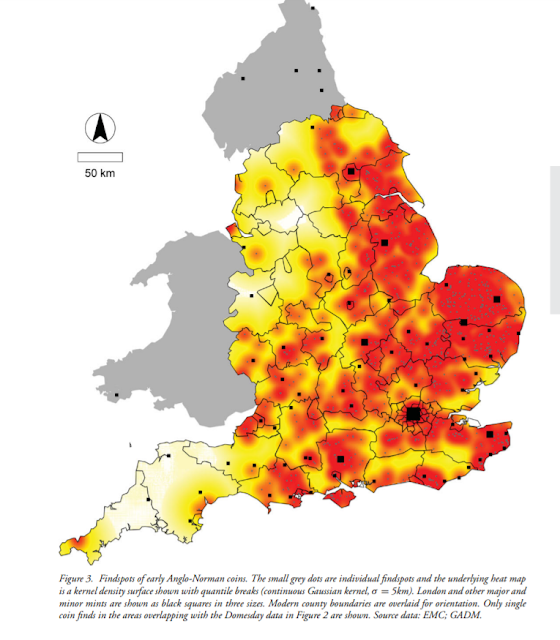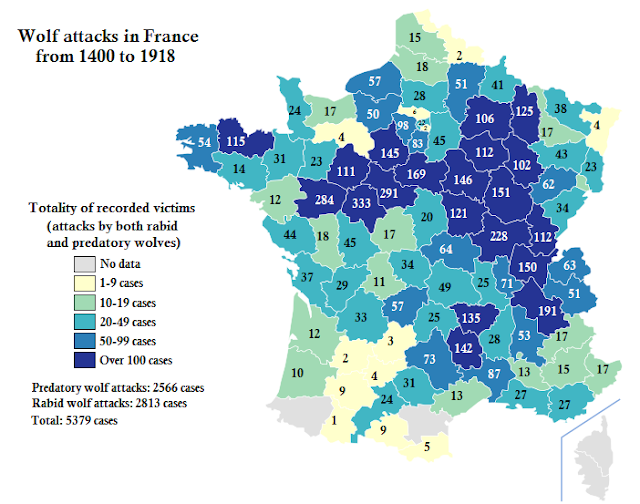Contrary to orthodox receieved wisdom that England after the Neolithic was one big farmstead, analysis of settlement names from Anglo-Saxon and Norse Language indicate extensive settlement into a wooded landscape. There can be no doubt from this that Forest cover was greater in 1300, 1086 and 665 that today.
Saturday, 5 January 2019
Wednesday, 2 January 2019
Northern Forests in Roman England
So if we look at Roman Coin finds in England, it mirrors later population patterns and coin finds from Norman England. The Population of Roman Britain was perhaps 4-6 million at height, with settlement most in the Eastern Arable areas, while in the Pastoral north, we have lower population and fewer towns and cities.
If we project the later Anglo-Saxon Forests onto the coin find map, we see similar patterns.
Now archaeologists and modern geographers maintain that forests were extensively cleared in neolithic times and that the barren moors of the North, once forested were cleared and then farmed with sheep before Roman occupation. While the Brigantes did have sheep in their diet, the historical record of Anglo-Saxon Ley name places - ie clearing in woods along with the survival of wolves, wild boar, deer, and even a cave bear in Yorkshire does tend to suggest that forestation in Yorkshire was more extensive into Roman times and the Middle Ages than current thinking. If agriculure co-existed with forestation, perhaps the presence of agriculture in pollen samples does not exclude the survival of wooded landscapes. Evidence abunds for the survival of large numbers of Wolves in the North and the West :
In the eleventh year of Henry VI's reign (1433), a Sir Robert Plumpton held a bovate of land called “Wolf hunt land” in Nottingham, by service of winding a horn and chasing or frightening the wolves in Sherwood Forest. The wolf is generally thought to have become extinct in England during the reign of Henry VII (1485–1509), or at least very rare. By this time, wolves had become limited to the Lancashire forests of Blackburnshire and Bowland, the wilder parts of the Derbyshire Peak District, and the Yorkshire Wolds. Indeed, wolf bounties were still maintained in the East Riding until the early 19th century.[5]
Source: https://en.wikipedia.org/wiki/Wolves_in_Great_Britain
In Europe wolves survive in many countries where there is significantly higher levels of forestation that Modern England where deforestation and wolf hunting made the wolf population extinct.
A map of historic wolf attacks in France shows one of the reasons Wolves were hunted in England.
If we project the later Anglo-Saxon Forests onto the coin find map, we see similar patterns.
Now archaeologists and modern geographers maintain that forests were extensively cleared in neolithic times and that the barren moors of the North, once forested were cleared and then farmed with sheep before Roman occupation. While the Brigantes did have sheep in their diet, the historical record of Anglo-Saxon Ley name places - ie clearing in woods along with the survival of wolves, wild boar, deer, and even a cave bear in Yorkshire does tend to suggest that forestation in Yorkshire was more extensive into Roman times and the Middle Ages than current thinking. If agriculure co-existed with forestation, perhaps the presence of agriculture in pollen samples does not exclude the survival of wooded landscapes. Evidence abunds for the survival of large numbers of Wolves in the North and the West :
Certain historians write that in 950, King Athelstan imposed an annual tribute of 300 wolf skins on Welsh king Hywel Dda,[4] while William of Malmesbury states that Athelstan requested gold and silver, and that it was his nephew Edgar the Peaceful who gave up that fine and instead demanded a tribute of wolf skins on King Constantine of Wales. Wolves at that time were especially numerous in the districts bordering Wales, which were heavily forested.[5]
This imposition was maintained until the Norman conquest of England.[4] At the time, several criminals, rather than being put to death, would be ordered to provide a certain number of wolf tongues annually.[6]
The monk Galfrid, whilst writing about the miracles of St. Cuthbert seven centuries earlier, observed that wolves were so numerous in Northumbria, that it was virtually impossible for even the richest flock-masters to protect their sheep, despite employing many men for the job. The Anglo-Saxon Chronicle states that the month of January was known as “Wolf monath”, as this was the first full month of wolf hunting by the nobility. Officially, this hunting season would end on 25 March; thus it encompassed the cubbing season, when wolves were at their most vulnerable, and their fur was of greater quality.[1]In the eleventh year of Henry VI's reign (1433), a Sir Robert Plumpton held a bovate of land called “Wolf hunt land” in Nottingham, by service of winding a horn and chasing or frightening the wolves in Sherwood Forest. The wolf is generally thought to have become extinct in England during the reign of Henry VII (1485–1509), or at least very rare. By this time, wolves had become limited to the Lancashire forests of Blackburnshire and Bowland, the wilder parts of the Derbyshire Peak District, and the Yorkshire Wolds. Indeed, wolf bounties were still maintained in the East Riding until the early 19th century.[5]
Source: https://en.wikipedia.org/wiki/Wolves_in_Great_Britain
In Europe wolves survive in many countries where there is significantly higher levels of forestation that Modern England where deforestation and wolf hunting made the wolf population extinct.
A map of historic wolf attacks in France shows one of the reasons Wolves were hunted in England.
Tuesday, 1 January 2019
Population, Coinage, Agriculture and Forestation in the North
If we compare maps of Roman and Norman coin finds with maps of population density, we find that coin density mirrors known population density in the North of England for Norman England. If we overlain Roman coin finds in the North with Norman, we see a near exact fit, which implies similar land use and perhaps population levels.

 |
| Anglo-Norman Coin Finds |
 |
| Roman Coin Finds |
 |
| Roman & Norman Coin Finds Compared |
 |
| Domesday Population 1086 Mapped So if we look at 2009 land use we can see the pastoral zone is the area with lower population |

Merry Wakefield, Forrestation and Robin Hood
It is in the Wakefield Rolls we find the strongest candidate for the many Real Robin Hoods, Robert Hood lived in Wakefield with his wife Matilda at Bichill - now the site of Wakefield Bus Station.
Local Historians in the 1970's took the time to map historic land use in Wakefield, and these can be viewed at Wakefield Museum and Library.
Waca's Field was a settlement - a clearing into the uncleared Forest of Barnsdale with the Great Marsh separating the small hamlet from Sandala. The area would have still been part of the British forest Kingdom of Elmet with Anglian settlement from the East with the Anglian Kingdom of Deira
Local Historians in the 1970's took the time to map historic land use in Wakefield, and these can be viewed at Wakefield Museum and Library.
Waca's Field was a settlement - a clearing into the uncleared Forest of Barnsdale with the Great Marsh separating the small hamlet from Sandala. The area would have still been part of the British forest Kingdom of Elmet with Anglian settlement from the East with the Anglian Kingdom of Deira
After the defeat of Elmet at the hands of the Northumbrians - Deira and Bernicia, Viking invasion and settlement into Bys and Thorpes let to further in roads into Barnsdale in Wakefield.
By the time of the Norman Invasion in 1066, we see depopulation caused by the Harrying of the North by King William I.
By the Age of Robin Hood in 1300, the deforestation of Barnsdale which was an Anglo-Danish hunting forest used by Canute and the Confessor, the Normans protected Sherwood but not Barnsdale, which was a place of Anglo-Saxon Brigandage.
The Woodland continues to diminish but still plays a role as can be seen in 1460 with the Battle of Wakefield.
Nostell Priory, St Austin and Robin Hood
The Wakefield Rolls record a Robert Hood who lived in Wakefield in 1316 with his wife Matilda, he was son of Adam Hood, a forester. Some think that had property in the Village of Wragby, the parish church is set in the grounds of Nostell Priory. The Priory was founded in 1120 in the Reign of King Henry I by his chaplain Ralph Adlave as a Priory for the Canons of St Austin, on the site of a church set in St Oswalds Wood which had been occupied by Christian monks and hermits from 665 AD who had built the Church and a little hall. The Priory was decicated to St Oswald and the Norman Baron Robert de Laci granted land in Hardwick to support it.
In the Gest of Robin Hood, the little known Saint Austin is referenced by King Edward who entered the Greenwood in the guise of an Abbot
They all kneeled down on their knee
Fittingly, before Robin;
The king noted this himself,
And swore by Saint Austin,
‘Here is a wondrous, goodly sight
I think, by God’s agony,
His men are more at his bidding
Than my men are at mine’.
Very quickly was their dinner prepared,
And in to eat they went;
They served our king with all their might,
Both Robin and Little John.
Right in front of our king was set
The fat venison;
The good white bread, the good red wine,
And also fine ale, and brown.
‘Make good cheer’, said Robin,
‘Abbot, for charity,
And because of this same tiding,
Blessed may you be.
Nostell Priory's wooded landscape is on the edge of the Went Valley that leads to Wentbridge, and it would have been an established order at the time of Robin Hood, in the Wragby Parish Church, ancient yew trees dating back to the middle ages grow in the churchyard, These were used for bows used by Robin, Little John and the Merry Men as referenced by the Gest.
Then up spoke Little John,
To Much he did say,
‘I dare lay my life in pledge,
That these monks have brought our pay.’
‘Be of good cheer,’ said Little John,
‘And ready our bows of yew,
And look your hearts be strong and sober,
Your strings trusty and true.
The monk has two and fifty men,
And seven packhorses strong;
There rides no bishop in this land
So royally, as I reckon.
Brethren,’ said Little John,
‘Here are no more than we three;
Unless we bring them to dinner,
Our master we may not see.
Bend your bows,’ said Little John,
‘Together you must stand;
The monk at the front, his life and his death,
Are held in my hand.
The Church of St Michael and Our Lady - built in the 1533 after the destruction of the Priory at the hands of Henry VIII on the site of an earlier medieval church is dedicated to St Michael and the referencing of "Our Lady" eight times by Robin Hood in the Gest, including his building a chapel in Barnsdale to Our Lady, so the church may stand on the site of a candidate for Robin Hood's Barnsdale chapel, along with South Kirkby and Campsall.
Subscribe to:
Posts (Atom)










